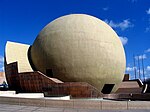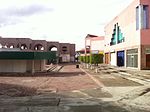Zona Río

Zona Río (English: "River Zone") is an official zone, and the main modern business district, of the city of Tijuana, Mexico. Zona Río is located at a strategic point, in the north of the city, about 1 mile (1.6 km) from the U.S.-Mexico border and 9 miles (14 km) from Downtown San Diego. The Río Zone is within the Delegación Centro, or Central borough, of Tijuana. The old downtown of Tijuana, Zona Centro, borders Zona Río on the west. The Zona Río is home to most of the regional headquarters for commercial and financial businesses and health services. The city's largest mall, Plaza Río Tijuana, the central market, and the majority of Tijuana's larger hotels and upscale restaurants are also located here, along Zona Río's three main avenues, Paseo de los Héroes, Avenida Padre Kino and Boulevard General Rodolfo Sánchez Taboada. The Zona Río office space submarket had, in 2016, 111,059 square metres (1,195,430 sq ft) of class A and B office space, with another 25,043 square metres (269,560 sq ft) in the contiguous Agua Caliente submarket, for a total of 136,102 square metres (1,464,990 sq ft). As such, the area can be considered an edge city.Although being comparatively small in comparison with other Mexican cities main business districts, such as those of Monterrey and Guadalajara, Zona Río has notable skyscrapers, which due to the relative distance between them, are very prominent. The tallest buildings are the 28-story twin towers that are home for the Plaza Aguacaliente and Grand Hotel Tijuana, commonly known by locals as Las Torres or The Towers.
Excerpt from the Wikipedia article Zona Río (License: CC BY-SA 3.0, Authors, Images).Zona Río
Avenida Vía Rápida Oriente, Tijuana
Geographical coordinates (GPS) Address Nearby Places Show on map
Geographical coordinates (GPS)
| Latitude | Longitude |
|---|---|
| N 32.530939 ° | E -117.017616 ° |
Address
Avenida Vía Rápida Oriente
22010 Tijuana
Baja California, Mexico
Open on Google Maps








